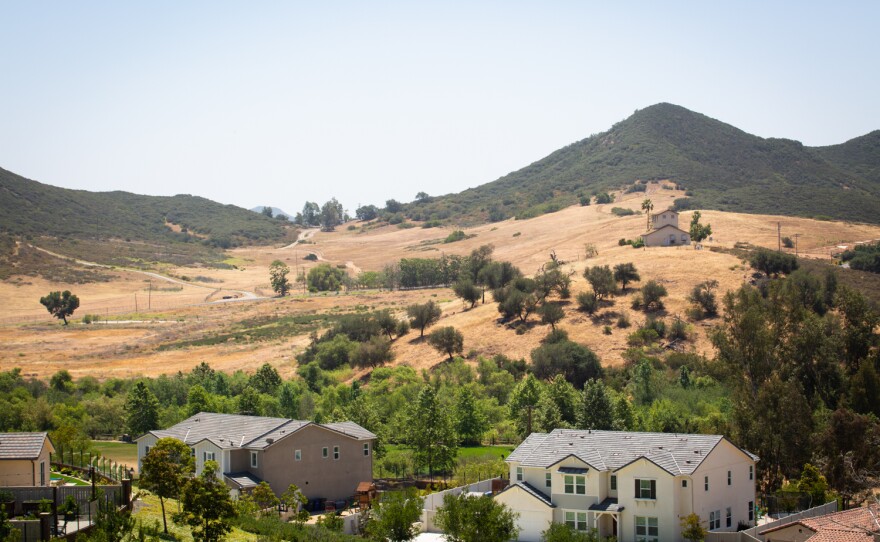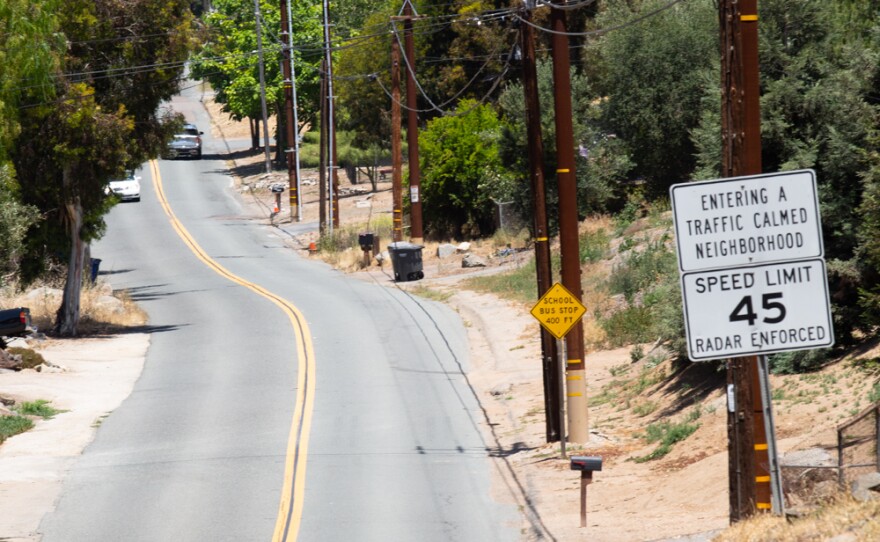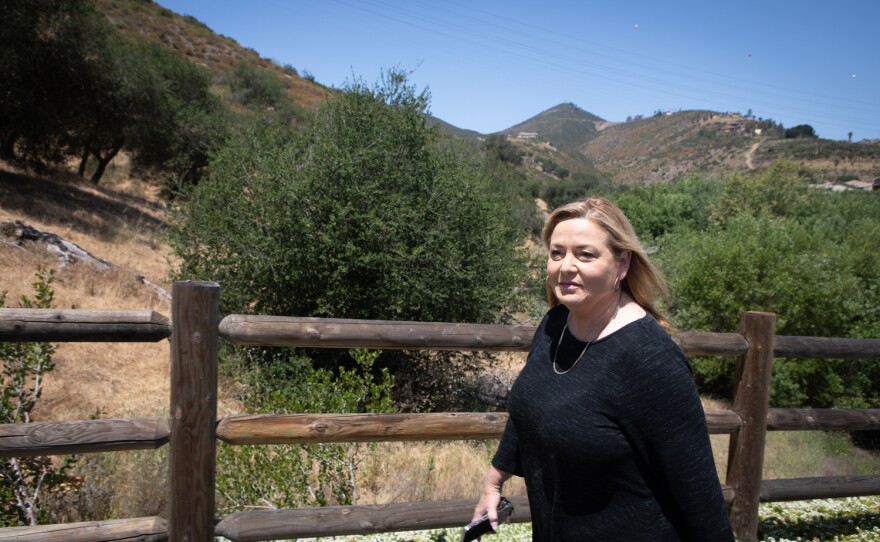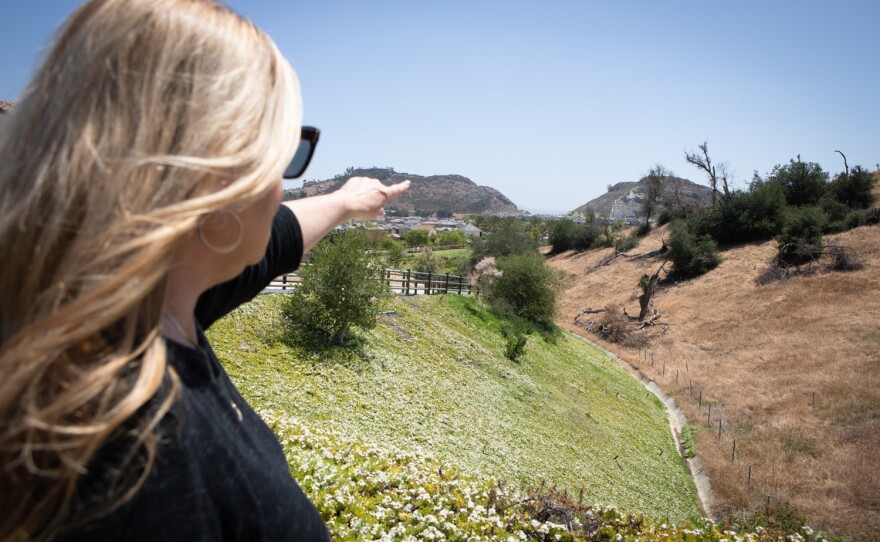One by one, developers sold local government officials in recent years on the promise of adding thousands of much needed homes to the San Diego region by placing them in the rural fringes of North and East County — including in areas where brush fires had recently burned down homes and clogged evacuation routes.
The environmental reviews, required by state law, repeatedly said they were safe. The projects got the ok from local fire officials and elected officials.
But in at least six major developments, critics say, there was a problem. All of these reviews were done by consultants hired by the very developers who want to build the homes. In six lawsuits brought in the last four years, challengers suing to block the developments said the reviews were flawed and incomplete, distinguished by a failure to fully analyze how new housing would clog evacuation routes or lead to more fires.
Now, those challenges are increasingly gaining traction, notching incremental victories in court and reshaping how local officials review development in fire-prone areas.
In February, the San Diego County Board of Supervisors adopted a new policy that county leaders say will limit new development in rural high fire risk areas.
A San Diego County spokesperson told inewsource the county is also considering overhauling how it does the reviews, including the county’s reliance on developers to study projects – but nothing has changed so far.

In three recent cases, judges have ruled that local officials failed to fully analyze the wildfire risks of large-scale housing developments, resulting in those projects being blocked, some with more finality than others.
- In the Harmony Grove Village South project near Escondido, which promised 453 homes, a superior court blocked the project out of fire safety concerns. However, an appeals judge disagreed with the lower court, saying fire officials have discretion to deem projects safe, though the judge blocked the development on other grounds related to emissions.
- A court also blocked the Fanita Ranch development in Santee, where nearly 3,000 homes were promised. The developer is working with local officials to redo the review.
- A project called Otay Ranch Village 14, promising 1,119 housing units east of Chula Vista, also was blocked in court. The decision has been appealed. But the project faces a powerful opponent: California Attorney General Rob Bonta has joined plaintiffs in arguing that local officials failed to fully analyze the wildfire risks of the project.
“As these mega-disasters become the norm, it is more critical than ever that we build responsibly,” Bonta said after the project was blocked, referring to fires fueled by climate change. “We can’t keep making the same mistakes.”
“Local governments have a responsibility to address wildfire risks associated with development projects at the front end,” he added. “Doing so will save dollars – and lives – down the line.”
One project facing a lawsuit, Newland Sierra, was blocked by voters in a 2020 referendum. In another case, against Valiano, the plaintiffs concerned about wildfire risks reached a confidential settlement. A third lawsuit, against Otay Ranch Resort Village 13, remains ongoing.
Developer consultants feed officials information
The blocked projects drew criticism in part because they required exemptions from the general plan, which governs safe development in the county.
Developers have a great deal of influence on county staff and officials. Local officials hand off the task of analyzing the safety of projects to consultants hired by the developers. Inherent in that exchange, critics say, is potential for conflicts of interest that do not serve the future residents of these developments if officials defer to the consultants and do not conduct independent fire-safety reviews.
Dan Silver, the CEO of the Endangered Habitats League, which has sued over rural development projects, said the result is that the environmental reviews sometimes don’t provide a full picture to the public – especially when local government officials don’t dig deeper.
“They do review these (environmental reports), but they don't give them a hard look,” Silver said. “They don't question what the applicant's consultants come up with. They don't do their due diligence and hire independent experts on things like traffic, on things like fire evacuation, endangered species needs and requirements. They accept whatever the developer puts in front of them.”
inewsource reviewed thousands of pages of public records related to six housing projects flagged by lawsuits as problematic.

The environmental reviews, which can take months to write, are in-depth and cover hundreds of pages. But they also leave some key questions unanswered, including how quickly existing residents might evacuate in the case of a brush fire or whether more residents would lead to more fire starts.
Emails show county staff working closely with developers and their consultants to smooth the review process, with planning staff feeding fire officials talking points they need to cover when presenting projects to the county leaders for approval.
When asked by inewsource about criticism of how the projects were approved, county spokesperson Donna Durckel defended the process, saying working closely with the project developers and consultants is essential to processing applications and that projects are not brought before decision makers until staff is satisfied that all requirements are met.
Asked how often the county seeks an independent review, Durckel said for some projects fire officials will use an independent consultant to evaluate the project’s safety. She did not specify how often that happens.
Neighbors who fled fire sue project
Susan Williams understands the appeal of living in a brand-new development in the hills, but her enthusiasm has dimmed as she learns more about the wildfire risk.
Williams bought a home in a new development near Escondido in 2016.

But she later learned that a brush fire had torn through the area while it was still being graded in 2014. Recently, her home insurance jumped, which she attributed to insurers shying away from the high fire risk in the area.
“They know what the developers won't admit and what the government officials won't admit,” Williams said. “It's not a good risk. It doesn't pencil out.”
She said she may not have moved in at all had she known about the wildfire risk and fears having to flee a wildfire along a narrow two-lane road.
During the 2014 Cocos Fire, neighbors were stuck in gridlock traffic while attempting to evacuate – and that was before 700 homes were built in Williams’ neighborhood and before developers pitched doubling that number.
Consultants for the developer of Harmony Grove Village South analyzed evacuation routes for the project – but counted only the people fleeing the proposed developments, not all existing residents. They estimated it would about 90 minutes to evacuate.
J.P. Theberge has lived in Elfin Forest near Escondido for 11 years. He is a member of a local group that advises the county on planning. The group hired an expert, conservation consultant Matt Rhan, to evaluate the evacuation plan, and later sued the development.
Rahn questioned the road’s design, saying the road should be wider for a much longer stretch, and said the evacuation would take longer than consultants determined. He also said the review should have considered other factors, such as time needed to evacuate pets and residents with disabilities and overall time it would take to evacuate everyone.
“The question is, which experts do we listen to? At the end of the day, you’re relying on someone whose income depends on this project getting through,” said Theberge.
In the case against Harmony Grove Village South, an appeals judge ruled that the Board of Supervisors had the discretion to choose to believe its fire officials over outside experts. The judge also ruled against the project for failure to provide affordable housing and mitigate greenhouse gas emissions.

But in other projects that have been challenged, the courts have flagged issues with the integrity of the environmental reviews ultimately approved by fire officials, pointing to gaps in how information was analyzed and presented to the public.
For example:
- In Oct. 2021, the San Diego County superior court judge who tentatively struck down the Otay 14 development east of Chula Vista agreed with plaintiffs who said local officials failed to analyze how adding people to the area could lead to more fires because most fires are caused by humans.
The developer’s consultant doing the review acknowledged in a memo that increasing population in Southern California would lead to more human-caused fires, but the final environmental review, according to the judge, “does not acknowledge an increase in risk of wildfire ignition as a result of more humans being in the area from the project.”
The case is under appeal.
- On March 3, 2022, another San Diego County superior court judge struck down the Fanita Ranch plan for nearly 3,000 homes in Santee in a scathing rebuke of the city of Santee’s evacuation analysis. Of the three evacuation routes identified, one dead-ends in a park.
Additionally, the city did not model evacuation scenarios or estimate evacuation times, according to the judge, who added that what methodology the consultants did use to analyze the safety of evacuations was “problematic.”
“The public was not informed as to the extent to which the project would expose them to significant risk of loss, injury or death regarding evacuation timing,” Judge Katherine Bacal wrote in her opinion. “Nor does the plan inform as to the risk of injury or death if residents are instructed to remain on site while the fires burn around them.”
San Diego leads similar regions in risky development
The fight over what fire safety should look like in the court-blocked housing developments underscores a major challenge facing local leaders and developers.
San Diego needs more housing to combat a scarcity of homes and climbing rents and home prices. Meanwhile, the risk of brush fires blankets much of San Diego County.
Proposing solutions, developers say they can build housing safely in areas at risk for brush fire by meeting and exceeding modern fire codes. In some cases, they argue, developments can increase fire safety by bringing new fire stations to the area and reducing flammable vegetation.
Lori Holt Pfeiler, the president and CEO of the San Diego Building Industry Association, said the developments that have been sued and delayed over wildfire risks would help balance home prices in the San Diego region and provide homes to people stressed about not having a home for raising their families.
Holt Pfeiler said she supports improving the review process to limit lawsuits, but she also believes the environmental reviews have been thorough. Still, lawsuits against developments will likely continue, she said, adding that’s unfortunate.
“I think it’s a huge detriment that we don’t support the housing that we need,” Holt Pfeiler said.
inewsource reached out to five San Diego County supervisors, including Chairman Nathan Fletcher, for their input on the county’s development practices and only one provided a response. Supervisor Terra Lawson-Remer pointed to the change in the makeup of the board as a sign of positive change.
“The old guard Board of Supervisors too often prioritized the special interests of big developers over the safety of County residents and our environmental quality of life,” she said.
The San Diego region does stand out statewide in how much housing is approved in high fire risk areas.
According to an analysis by University of California, Berkeley, both the city and county of San Diego approved more housing in fire prone areas than the city and county of Los Angeles and communities outside of Sacramento, which were selected because of their rapid development beyond major cities.
Courts have also recently ruled against projects in Los Angeles and Lake counties because of their wildfire risk. But the San Diego region’s topography and geography, characterized by a lot of open space, has led to unique development pressures and several projects where fire risks haven’t been adequately assessed, according to Peter Broderick, an attorney at the Center for Biological Diversity who has sued some of the developments.
“What we're seeing (in San Diego County) is a particularly egregious sort of set of examples of something that's actually happening in lots of places in California,” he said.









